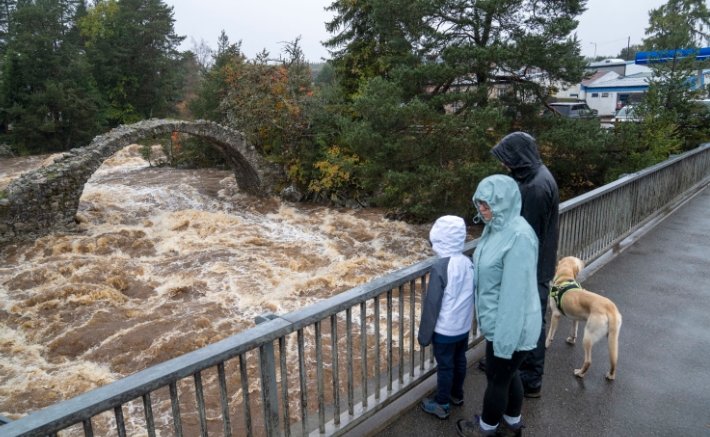Scotland is grappling with worsening floods driven by climate change, with a new report highlighting urgent gaps in protection efforts. Released on August 28, 2025, by Audit Scotland, the findings warn that without swift fixes, more communities could suffer as risks climb sharply by 2080.
Flooding Threats Grow in Scotland
Flooding has become a pressing issue across Scotland, fueled by changing weather patterns. The report states that around 284,000 properties face flood risks today, a number projected to swell to nearly 400,000 by 2080. This rise stems from heavier rainfall and rising sea levels, putting homes, businesses, and lives in danger.
Experts point to recent events like Storm Babet in 2023, which caused widespread damage and showed how climate shifts are already hitting hard. Public bodies aim to shift from just managing risks to building real resilience, as outlined in the Scottish Government’s National Flood Resilience Strategy launched in December 2024.
This strategy sets a vision for a flood-resilient Scotland by 2045, focusing on community involvement and diverse actions. Yet, the report flags that progress is slow, with inequalities likely to widen if vulnerable groups are not prioritized.

Key Impacts on Communities and Health
Floods bring more than water damage; they disrupt lives in profound ways. People often face evacuation, costly repairs, and long-term stress, which can harm physical and mental health.
The report lists several major effects:
- Risk to life from fast-rising waters.
- Direct property damage forcing relocations.
- Loss of access to essentials like food, work, and medical care.
- Lower home values and insurance struggles in high-risk zones.
These issues hit harder in deprived areas, deepening health gaps. For instance, flooding can trigger anxiety and trauma, making people feel unsafe in their own homes. Public Health Scotland notes that such events widen inequalities, especially for those without insurance or support networks.
Recent data from 2025 shows over 1,800 homes affected by floods in the UK this year alone, underscoring the human toll. Communities need better preparation to bounce back faster, but gaps in resources hold this back.
Gaps in Leadership and Funding Exposed
The Audit Scotland report praises some successes, like councils teaming up with locals on flood schemes. However, it uncovers big problems in leadership, data sharing, and skills.
Costs for major flood protection projects are soaring, protecting fewer homes than planned. Funding uncertainty looms large, with the current setup deemed unfit for purpose. The Scottish Government has earmarked an extra 15 million pounds in the 2025-2026 budget for resilience work, but the report calls for clearer timelines and more efficient delivery.
Without fixes, ambitious goals in the National Flood Resilience Strategy may falter. More action is needed on land use to prevent worsening floods, such as restoring peat bogs and planting woodlands to hold water upstream.
A 2025 conference on flood resilience highlighted innovative ideas, like AI-driven warnings and community-led plans. Yet, the report stresses that without strong leadership, these efforts won’t scale up fast enough.
| Challenge | Current Issue | Recommended Fix |
|---|---|---|
| Leadership | Gaps in coordination between bodies | Set clear roles and timelines for strategy actions |
| Funding | Rising costs and uncertainty | Provide clarity on available funds for schemes |
| Skills | Shortage of experienced staff | Build workforce with right expertise for councils |
| Data | Incomplete information sharing | Ensure all parties have needed flood risk data |
| Community Prep | Low awareness of risks | Boost education on preparation steps |
Steps Toward Stronger Flood Resilience
To tackle these issues, the report urges immediate changes. Public bodies must clarify roles, share better data, and secure stable funding for flood schemes.
Building skills is key, as councils lack enough experts to plan and execute projects. The strategy pushes for broader partnerships, including with private sectors, to speed up diverse flood management.
Innovative approaches, like green infrastructure and early warning systems, show promise. For example, replanting uplands can reduce downstream risks, as seen in successful pilots. Communities should get tools to prepare, such as property-level protections and emergency plans.
Targeted support for at-risk groups can prevent inequalities from growing. With climate change accelerating, Scotland must act now to protect its people.
What Communities Can Do Now
Individuals and groups play a vital role in building resilience. Simple steps like checking flood risk maps and installing home defenses can make a difference.
Local forums, like those run by the Scottish Flood Forum, offer advice and support. Recent X posts from experts emphasize working with nature, such as restoring bogs to store water and cut flood peaks.
By staying informed and involved, residents can push for better protections. The 2025 flood resilience conference recordings provide free insights on best practices.
Share this article with your network to spread awareness about Scotland’s flood challenges. What steps have you taken to prepare for floods in your area? Comment below and join the conversation.


















